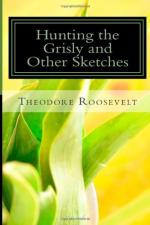In the old days when the innumerable bison grazed free on the prairie, the grisly sometimes harassed their bands as it now does the herds of the ranchman. The bison was the most easily approached of all game, and the great bear could often get near some outlying straggler, in its quest after stray cows, yearlings, or calves. In default of a favorable chance to make a prey of one of these weaker members of the herds, it did not hesitate to attack the mighty bulls themselves; and perhaps the grandest sights which it was ever the good fortune of the early hunters to witness was one of these rare battles between a hungry grisly and a powerful buffalo bull. Nowadays, however, the few last survivors of the bison are vanishing even from the inaccessible mountain fastnesses in which they sought a final refuge from their destroyers.
At present the wapiti is of all wild game that which is most likely to fall a victim to the grisly, when the big bear is in the mood to turn hunter. Wapiti are found in the same places as the grisly, and in some spots they are yet very plentiful; they are less shy and active than deer, while not powerful enough to beat off so ponderous a foe; and they live in cover where there is always a good chance either to stalk or to stumble on them. At almost any season bear will come and feast on an elk carcass; and if the food supply runs short, in early spring, or in a fall when the berry crop fails, they sometimes have to do their own killing. Twice I have come across the remains of elk, which had seemingly been slain and devoured by bears. I have never heard of elk making a fight against a bear; yet, at close quarters and at bay, a bull elk in the rutting season is an ugly foe.




